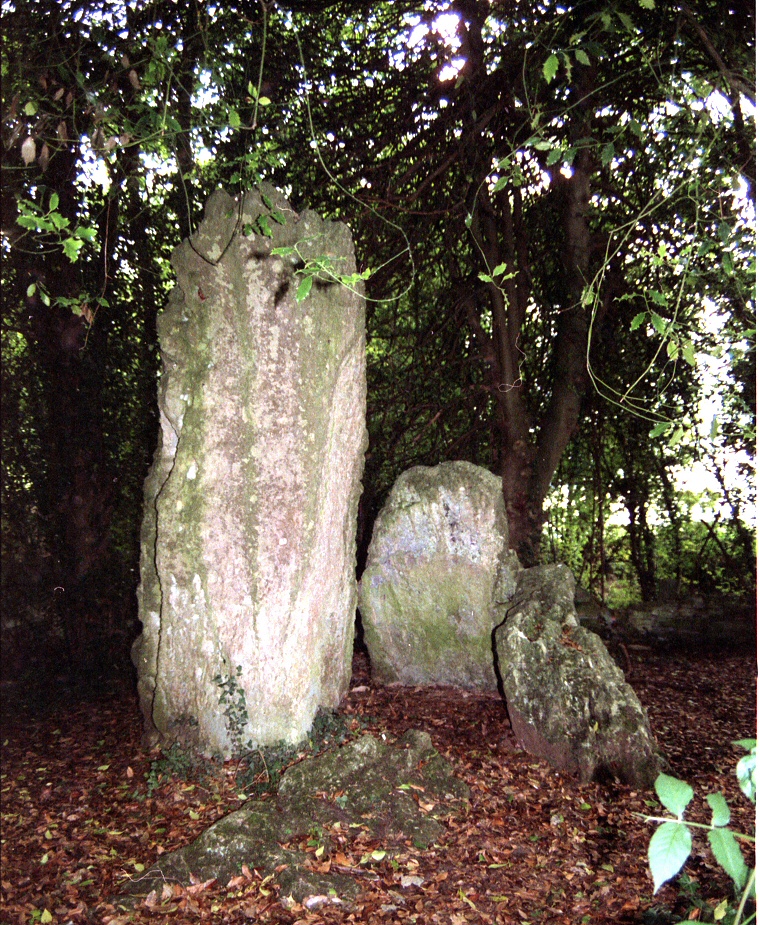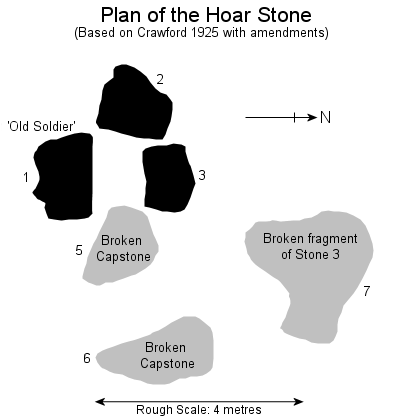
What now remains are three orthostats still standing and a further three fallen and partly buried slabs. The largest stone to the south, known as 'the Old Soldier' (marked as '1' on the plan below, amended from Dryden & Lukis 1840 as printed in Crawford 1925), is some
 2.6 metres tall while the short stump to the north (stone 3) is the base of a now broken stone, the rest of which lies a short distance to the northeast (stone 7, erroneously marked as 'capstone' on the 1840 plan). They form three side of a rectangular box chamber open to the east with the remains of the fallen and broken capstone (stones 5 & 6) in front of them - this capstone is the flat stone covered with leaves in the foreground of the photograph above. The blocking or 'portal' stone that gives these sites their name and would be expected to stand between stones 1 and 3 is now missing. Given the size of the stones the internal chamber area was quite small being only about 1.5 metres east-west and 1 metre north-south although we do now known how many other stones are missing from the site.
2.6 metres tall while the short stump to the north (stone 3) is the base of a now broken stone, the rest of which lies a short distance to the northeast (stone 7, erroneously marked as 'capstone' on the 1840 plan). They form three side of a rectangular box chamber open to the east with the remains of the fallen and broken capstone (stones 5 & 6) in front of them - this capstone is the flat stone covered with leaves in the foreground of the photograph above. The blocking or 'portal' stone that gives these sites their name and would be expected to stand between stones 1 and 3 is now missing. Given the size of the stones the internal chamber area was quite small being only about 1.5 metres east-west and 1 metre north-south although we do now known how many other stones are missing from the site. It is probable that the chamber would have been surrounded on at least three side by a low mound or cairn of stone and rubble, this has since been removed although traces of it were apparently still visible in the early 19th century. The plan of the Whispering Knights chambered tomb 11km (7 miles) to the northwest is probably a good approximation of what the cairn would have looked like.
Given the ruinous state of the tomb it is likely to have been rifled for potential treasure in the past (no doubt unsuccessfully as grave good of any description were rare at this point in prehistory) and there are no records of any remains from within the chamber itself, the only finds being sherds of later Romano-British or Roman pottery with some Roman coins found nearby.
In my original notes for the site I wrote:
'In the great scheme of British prehistoric monuments, the Hoar Stone does not figure highly, however, to consider these remains as of little interest would be wrong. This is a site that at first does not want to be found, does not want to be photographed. The first time I visited, I drove past it at least three times, passing within 10 feet of the stones. I only located them with the assistance of some local walkers. The Hoar Stone stands almost invisible, yet only a few feet from a narrow road, in the dappled shade of Enstone plantation. Even O. G. S. Crawford writing in the 1920's described it as 'practically invisible to passers by'. I tried to take photographs but they failed to come out and had to wait for a further year before I could return, this time with a tripod and flash unit to get the picture above and coming back to the stones was like a welcome journey to visit an old friend, it is a magical site that draws one back to it time and time again.'
Local legend says that the stones will return to their places if anyone tries to move them, and that on Midsummer's Eve, the Old Soldier travels down to the village to drink. The term 'Hoar' which also applies to several other monuments, is thought to originate from the Great Goddess Hoeur.
Site Visits / Photographs:
August 1999, August 2000.
References:
.
Cope, J. 1998. The Modern Antiquarian. A Pre-Millennial Odyssey through Megalithic Britain. London: Thorsons.
Crawford, O. G. S. 1925. The Long Barrows of the Cotswolds. Gloucester: John Bellows.
Darvill, T. 2004. Long Barrows of the Cotswolds and surrounding areas. Stroud: Tempus Publishing Ltd.
Dyer, J. (Editor). 1993. Discovering Prehistoric England. Princes Risborough: Shire Publications Ltd.
Evans, A. 1895. The Rollright Stones and their Folklore. Folk-lore, Vol 6, 6-51.
Hawkes, J. 1986. The Shell Guide to British Archaeology. London: Michael Joseph Ltd.
Lynch, F. 1997. Megalithic Tombs and Long Barrows in Britain. Princes Risborough: Shire Publications Ltd.
Plot, R. 1677. The Natural History of Oxfordshire. Oxford:
NMR Number: 21800.
Oxfordshire Historic Environment Record Number: 2256